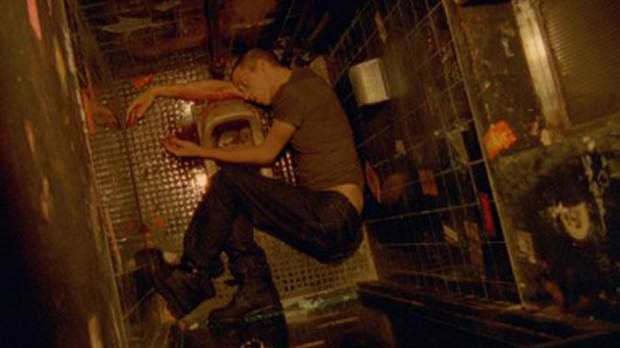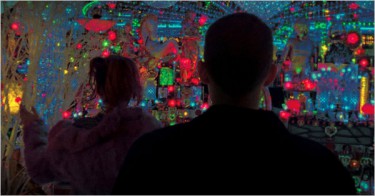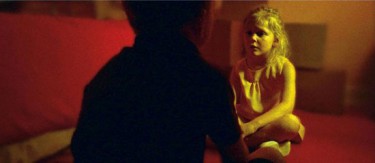 Back to selection
Back to selection
A Movie is Like a Person: Enter the Void

“Then, too, there is always something other than content in the cinema to grab hold of, for those who want to analyze,” Susan Sontag wrote in her seminal essay Against Interpretation. “For the cinema, unlike the novel, possesses a vocabulary of forms — the explicit, complex, and discussable technology of camera movements, cutting, and composition of the frame that goes into the making of a film.” Toward the very end of the same essay, she advocated, “The function of criticism should be to show how it is what it is, even that it is what it is, rather than to show what it means.”
One senses that cinema’s “vocabulary of forms” is typically under-utilized, much in the same way that our brains only realize about 10% of their potential. While there are any number of cinematic languages that could exist, most of the time films tend to rely heavily upon what we could call the basics of film grammar – shot/counter-shot, close-ups, wide shots, over-the-shoulders and reverses, as well as certain editing paces and conventions of lighting and score. This film grammar is sort of cinema’s “default mode” for presenting the world via filmmaking. It’s not so dissimilar from how each individual has their own way of experiencing and existing in the world — we all have ways of seeing and hearing, acting and reacting, that are so deeply embedded within us that they’re unrecognizable to us, second nature. The difference between this and film grammar is that while the same film grammar is employed in so many films, one can imagine that the endless variations on the individual require that each person has a entirely unique way of experiencing life.
The poet Earl Coleman used to tell me that “Art, at its best, marries the artist to the world.” What he meant was that art of merit had something to communicate, something to say that would be relevant to pretty much everyone. True though that may be, at times I’ve found it useful to focus on the statement from a different perspective — that it is an individual artist who is being married to the world, one with his own singular way of comprehending existence, with his own peccadilloes and quirks and theories and intellectual structures for making sense of the chaotic hash that is life.
When this singularity of perspective is put forth in art, the stakes are automatically raised. A Hollywood genre entry, be it a rom-com or a thriller, has to adhere to the aforementioned film grammar — certain conventions of “camera movements, cutting and composition of the frame” that are to be taken as a given. To the audience member who more or less sees only Hollywood movies, there may seem to be some slight room for variation of directorial voice amongst the works observed; but to a viewer who has some breadth of cinematic knowledge, it’s apparent that the vast majority of mainstream films might as well have been directed by the same entity (there’s your 10%). A film directed by a more aggressively personal filmmaker, exhibiting a more aggressively personal form, raises the stakes beyond what we expect from a Hollywood assembly-line picture. Because David Lynch or Lars von Trier stray so far from common style, we expect more; what we expect, specifically, is a justification of the formalism. Oddly, we never feel that generic films have to justify their generic stylistic choices — that we can accept.
That an individual develops a specific way of interacting with the world seems necessary; if we were constantly in flux in terms of our mode of being, we would never be able to get things done – we’d be too aware of how we were perceiving the world, too literally self-conscious. (This kind of self-consciousness usually crops up when we do push ourselves outside our comfort zone a bit, by taking drugs, doing adventurous or strenuous activities, and so on.) What rarely comes to mind, however, is that this sort of singularity of rigid perspective is rarely put forward in cinema. Even the greatest directors to work in the medium allow for a certain slack in their style’s internal consistency. Moreover, while great filmmakers undoubtedly push the medium in new and interesting directions, rarely do they seem to impose concrete rules over how the camera may and may not present existence — in films, anything is possible, and that’s part of the fun.
 In Enter The Void, a formalist battle cry if there ever was one, anything most definitely is not possible. If you’re expecting a shot that isn’t either from the protagonist’s point of view (literally), from behind his head, or an overhead shot as his soul floats above the Earth, you will be disappointed. The kinds of shots available to the film are severely limited. Ironically, Enter The Void has been discussed as a boundary breaking, anything-goes work of chaos and madness and free-form beauty. It is that, even as it is a rigidly ordered, formally mindful film, a film that has been carefully structured to be absolutely consistent with its own internal logic. In making a film that is this singular and this consistent with its own rules of formal representation, Gaspar Noe has illuminated new possibilities inherent in cinematic form — namely, the way in which extremely strict formal adherence can replicate the way a mind works.
In Enter The Void, a formalist battle cry if there ever was one, anything most definitely is not possible. If you’re expecting a shot that isn’t either from the protagonist’s point of view (literally), from behind his head, or an overhead shot as his soul floats above the Earth, you will be disappointed. The kinds of shots available to the film are severely limited. Ironically, Enter The Void has been discussed as a boundary breaking, anything-goes work of chaos and madness and free-form beauty. It is that, even as it is a rigidly ordered, formally mindful film, a film that has been carefully structured to be absolutely consistent with its own internal logic. In making a film that is this singular and this consistent with its own rules of formal representation, Gaspar Noe has illuminated new possibilities inherent in cinematic form — namely, the way in which extremely strict formal adherence can replicate the way a mind works.
We don’t often think about how our minds work, how it must feel to be inside our heads – of course, you’re always inside your own head, but that makes the experience so common, so basic (“We don’t know who discovered water, but we know it wasn’t the fish,” Marshall McLuhan quipped) that it becomes invisible. For example — do you ever consider how incredibly bizarre it is that we can only experience existence through a POV shot based out of our own eyes? Isn’t that odd? And if you consider that film is meant to be a mimetic artform, why does it choose not to present life solely from POV angles?
It’s because movement into the realm of abstraction is necessary for cinema to find a its own way of representing existence, a parallel way that exploits the strengths of the medium. Going against this tried-and-true practice, Gaspar Noe uncomfortably forces us to see a movie as we see the world for the first thirty minutes of Enter The Void. It’s terribly disconcerting – the first act is the toughest to watch. You’re squirming, you’re annoyed by the “blinking,” you’re a little seasick due to the camera movement. After I saw the film for the first time, I felt myself experiencing a little out-of-body oddness as I walked through the Meatpacking District. Seeing the world through my own eyes, through a POV shot, suddenly felt uncomfortable and foreign. Noe had accomplished the terribly difficult task of literally getting me out of my own mode of existence, my own comfort zone.
That’s not all the film accomplishes. By rigidly structuring rules of what the camera can and cannot do — it can’t really show a memory from any angle other than behind Oscar’s head; when it’s from the point of view of his soul, it’s almost always floating overhead; the camera is not allowed to cut to any kind of reverses, inserts, or coverage of any other sort throughout the entire film — it exposes the laziness of most filmmaking as it constructs a unique style that works as a self-sustaining philosophy of film language. By employing a set of cinematic rules that is almost ascetic, the film indirectly indicts the laziness of the majority of film grammar, which relies on basic presumptions that are employed without being fully interrogated or justified. Enter The Void almost works as much as a work of film criticism as it does as film-making; it seems to be saying that every film must start at zero and justify every decision, every formal choice, with a philosophical rationale. It begs the question – do most filmmakers use traditional film language because it seems appropriate? Or because it’s available, it’s accepted, and they’re not creative enough to do what Noe has done?
 In all fairness to the rest of the filmmakers out there, what Noe has done is no small feat. He has built a self-sustaining cinematic form that runs according to its own logic and rules, much as a scientific system might. It’s a sight to behold. As Enter The Void pushes on, moving from its POV section to its memories section to its floating-soul section, the rigor and confidence of Noe’s direction becomes overwhelmingly seductive. It’s not purely formal — Enter The Void has much to talk about by way of how memories are structured and rework themselves, how we experience loss, and how our cognition may function (in some fantastic way) — but the film is ultimately about how our minds rigidly carve out a mode by which we experience existence. Noe makes that argument with such confidence that his direction reminded me of an object of attraction you meet at a bar or party; this person may not be the most interesting or smartest or funniest in the room, but they are so incredibly self-confident, so quietly assured of their decisions and choice of words, that you cannot help but fall into their orbit. Noe’s direction works by the same token, and it serves as a kind of advice for filmmakers: if you want your work to be engaging, direct your films with the utmost devotion to their logic and their style; deviate from the rules you establish for yourself as little as possible, if at all. Enter The Void is a compelling film because as it builds up its own world of cinematic language, the consistency of its style becomes overwhelming; this movie is a person, it is the inside of someone’s brain. This, of course, is a sensation we couldn’t grasp without the formal tools of cinema being employed in this fashion — being inside your own brain constantly means you have no idea how it must feel to be inside a brain.
In all fairness to the rest of the filmmakers out there, what Noe has done is no small feat. He has built a self-sustaining cinematic form that runs according to its own logic and rules, much as a scientific system might. It’s a sight to behold. As Enter The Void pushes on, moving from its POV section to its memories section to its floating-soul section, the rigor and confidence of Noe’s direction becomes overwhelmingly seductive. It’s not purely formal — Enter The Void has much to talk about by way of how memories are structured and rework themselves, how we experience loss, and how our cognition may function (in some fantastic way) — but the film is ultimately about how our minds rigidly carve out a mode by which we experience existence. Noe makes that argument with such confidence that his direction reminded me of an object of attraction you meet at a bar or party; this person may not be the most interesting or smartest or funniest in the room, but they are so incredibly self-confident, so quietly assured of their decisions and choice of words, that you cannot help but fall into their orbit. Noe’s direction works by the same token, and it serves as a kind of advice for filmmakers: if you want your work to be engaging, direct your films with the utmost devotion to their logic and their style; deviate from the rules you establish for yourself as little as possible, if at all. Enter The Void is a compelling film because as it builds up its own world of cinematic language, the consistency of its style becomes overwhelming; this movie is a person, it is the inside of someone’s brain. This, of course, is a sensation we couldn’t grasp without the formal tools of cinema being employed in this fashion — being inside your own brain constantly means you have no idea how it must feel to be inside a brain.
Enter The Void isn’t a perfect film — in fact, it has plenty of flaws — but it throws down the formalist gauntlet in a way that no other filmmaker has done in a while (well, at least since 2008’s Hunger). It by no means proposes that this kind of style — POV photography, behind-the-head photography and overheard shots — should be the basis for all, or even any other, films. Rather, what it proposes is that each film be crafted with the kind of attention to singularity and formal detail, the kind of discipline to adhere to its own logic, that Noe has displayed here. If more films were made in that fashion, with style being built from zero rather than assorted from the usual assembly-line parts, we might find an arrangement of films that were all unique, all singular, all with their quirks and peccadilloes, all lovely and odd in their own ways, and all of merit. Kind of like people.
Zachary Wigon is a New York-based screenwriter and film critic. Since graduating from NYU’s film school in 2008, he has contributed writing on film to The L Magazine, The Onion A/V Club, NYLON magazine and The House Next Door, amongst other outlets. His first feature screenplay, For Your Entertainment, is currently in pre-production.

